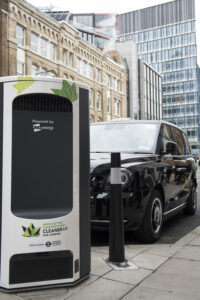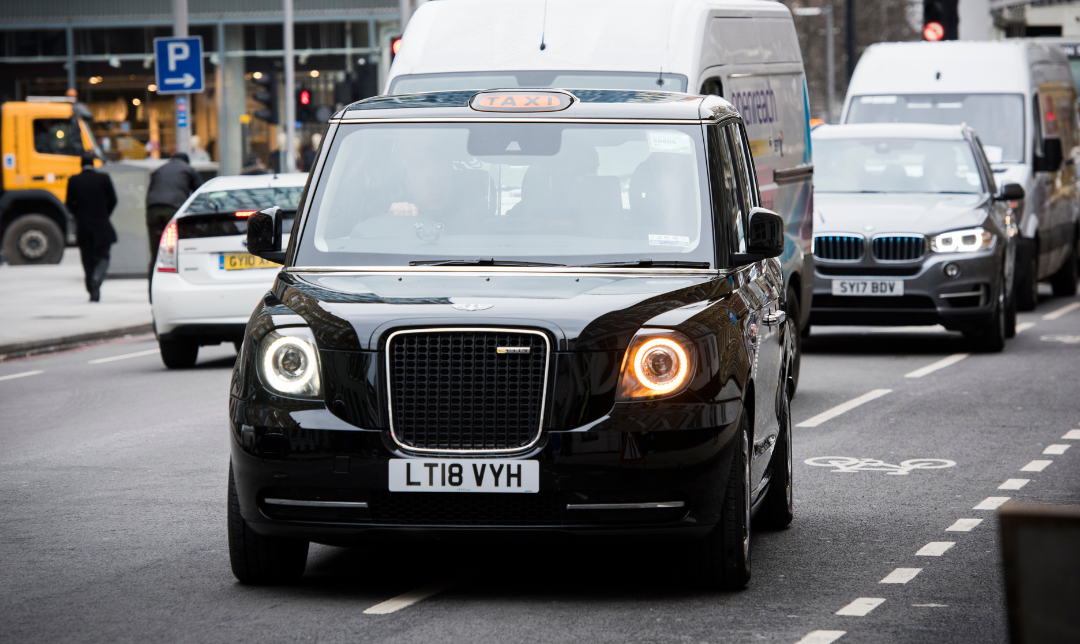By signing on to the Zero Emission Vehicles Declaration, London has joined 68 cities and regional governments in committing to work to convert its entire fleet of cars and vans to zero-emission vehicles (ZEVs) by 2035 and to incentivize the transition to ZEVs as soon as possible. This is the latest in a series of steps by London to support the adoption of electric vehicles and reduce air pollution from road transport.
The statistics tell the story. London had the most sales of new plug-in cars among European cities in 2021, approximately 24,000. Additionally, the share of plug-in cars in new car sales in the city increased from 12% in 2020 to 21% 2021—that was better than the United Kingdom’s share of 12%.
One notable example among the numerous policy measures to accelerate the ZEV transition is the Mayor of London’s efforts to reduce emissions from iconic black taxis, an important source of tailpipe pollution in the city. Ever since January 2018, black taxis registering for the first time need to be zero-emission capable (ZEC) with a minimum 30-mile zero-emission range and no more than 50 g/km of tailpipe CO2 emissions to get a license; additionally, older polluting taxis can stay in circulation for no more than 12 years. Through a government plug-in taxi grant, taxi drivers can receive £7,500 off the cost of a new ZEC taxi. The Mayor is also committed to expanding charging infrastructure, as set out in the Electric Vehicle Infrastructure Strategy, the Capital aims to install between 40,000 and 60,000 charge points by 2030, 4,000 of them rapid chargers. London has already had 11,500 public chargers installed at the end of 2022. That was more than a third of the United Kingdom’s total. In the coming year, Transport for London (TfL) is set to install an additional 100 public rapid charge point bays on busy roads, on top of 300 previously installed by TfL. Moreover, the London Electric Vehicle Infrastructure Delivery Plan published in 2019 targets delivering five rapid-charging hubs for taxis and commercial fleets, one in each sub-region, by 2025. Three have already been installed with support from TfL, in addition to 24 delivered by the private sector.
There’s more. London moved the date forward for a 100% zero-emission bus fleet from 2037 to 2034. Since September 2021, all new buses on the city’s streets must be zero-emission. By the end of 2022, 10% of the bus fleet was zero emission. With national government funding, London could potentially achieve a fully zero-emission fleet by 2030, and moving the date forward from 2034 to 2030 would result in an additional 1 million tonnes of avoided CO2 emissions.
Complementary policies also bring cleaner air

Rapid charge launch installed in London.
London’s air quality has significantly improved since 2016 and is now comparable to that of similar-size cities such as New York and Madrid. In addition to policies that focus on adding cleaner vehicles to the fleet, special zoning regulations helped bring about these gains. In 2019, the Mayor introduced an Ultra Low Emission Zone (ULEZ) in central London and drivers of older and highly polluting cars, vans and motorcycles must pay a daily charge to operate in it. In October 2021, the Capital made the zone 18 times larger, and the plan is for it to cover the entire Greater London area starting in August 2023. One year into the ULEZ expansion, harmful NO2 concentrations alongside roads are estimated to be 46 per cent lower in central London and 21 per cent lower in inner London than they would have been without the ULEZ and its expansion. The ULEZ targets decreasing NO2 emissions from vehicles burning fossil fuels, because it is one of the most harmful air pollutants along with particulate matter (PM).
The Capital also recently introduced a new £110 million scrappage scheme and its primary mission is to help prepare specific groups who would be most impacted by the ULEZ, including Londoners on lower incomes, disabled drivers, small businesses, and charities, for the future expansion of the zone to cover all London boroughs. This builds on the previous £61m scrappage scheme which helped to scrap or retrofit 15,200 older, polluting vehicles. Eligible London vehicle owners can apply for £2,000 for scrapping a car that does not meet the ULEZ emission standard, and wheelchair-accessible vehicles can receive a grant of up to £5,000 . London businesses employing 10 or fewer people, sole traders, and charities can receive a grant of up to £9,500 to scrap their vehicles or £5,000 to retrofit their vans and minibuses. Individuals and organizations can also benefit from discount offers for subscriptions to or rental of bikes, e-bikes, cargo-bikes, e-scooters, and car clubs to switch to cleaner forms of transport and avoid paying the ULEZ charge. Disabled people with eligible registered vehicles or on certain disability benefits, will be exempt from paying the ULEZ charge until late October 2027.
London is cleaning up its air by implementing policies that promote electric vehicles and reduce emissions from the most polluting vehicles on the road. Still, poor air quality caused by traffic remains a key concern, and it is associated with stunted lung growth in children and around 4,000 premature deaths in 2019. The work is not done, but in signing the ZEV Declaration, London has taken another important step forward in its efforts toward clean transportation and improved health for its residents.

